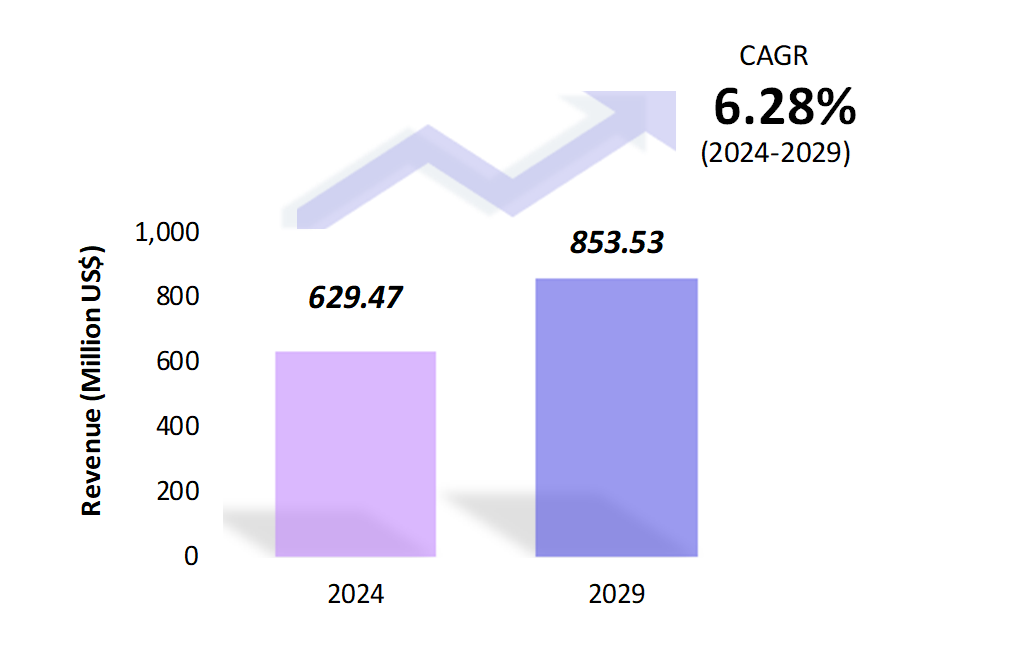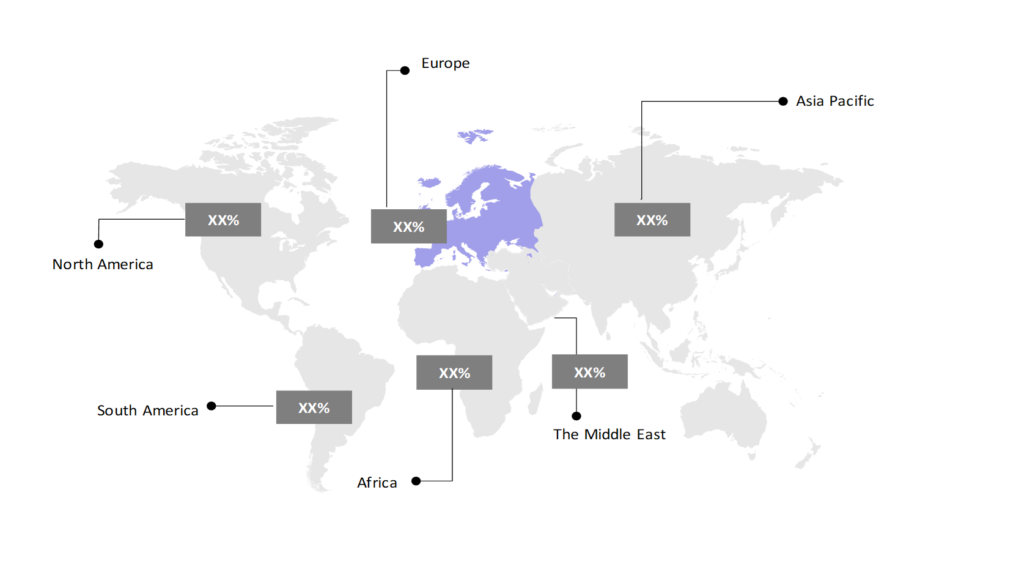Bio-based Leather Market Insights: Size, Share, Growth Analysis & Forecast (2024-2029)
The market report presents a thorough analysis segmented by Source (Mushroom, Pineapple, Apple, Cactus, Tree Bark, Leftover Fruits); by End-User Industry (Footwear, Garments, Accessories); by Geography (North America, South America, Asia Pacific, Europe, The Middle East, Africa).
Market Dimensions & Growth Potential

- The bio-based leather market is estimated to be at USD 629.47 Mn in 2024 and is anticipated to reach USD 853.53 Mn in 2029.
- The bio-based leather market is registering a CAGR of 6.28% during the forecast period of 2024-2029.
- The market for bio-based leather is characterized by a dynamic and rapidly evolving landscape. With advancements in material science and technology, companies are continuously improving the quality, durability, and aesthetics of bio-based leather.
Request a free sample.
Competitive Landscape & Market Positioning in 2023

- The participants in the global bio-based leather industry are always developing their strategies to preserve a competitive advantage.
- These companies primarily use acquisitions, R&D, partnerships, and technological launches.
- Several important entities in the bio-based leather market include Natural Fiber Welding, Inc., Ananas Anam Ltd., MycoWorks Inc., Modern Meadow, Inc., Ultrafabrics Holdings Co., Ltd., and others.
Ask for customization.
Report Objectives & Insights
| Attributes | Values |
| Historical Period | 2018-2022 |
| Base Year | 2023 |
| Forecast Period | 2024-2029 |
| Market Size (2024) | USD 629.47 Mn |
| Market Size (2029) | USD 853.53 Mn |
| Growth Rate | 6.28% CAGR from 2024 to 2029 |
| Key Segments | Source (Mushroom, Pineapple, Apple, Cactus, Tree Bark, Leftover Fruits); End-User Industry (Footwear, Garments, Accessories); Geography (North America, South America, Asia Pacific, Europe, The Middle East, Africa) |
| Key Vendors | Natural Fiber Welding, Inc.; Ananas Anam Ltd.; MycoWorks Inc.; Modern Meadow, Inc.; Ultrafabrics Holdings Co., Ltd. |
| Key Countries | The U.S; Canada; Mexico; Brazil; Argentina; Colombia; Chile; China; India; Japan; South Korea; The UK; Germany; Italy; France; Spain; Turkey; UAE; Saudi Arabia; Egypt; South Africa |
| Largest Market | Europe |
Get a free quote.
Market Trends & Future Outlook
- Sustainability and Ethical Consumption: Manufacturers are increasingly experimenting with various sustainable sources, such as mycelium, pineapple leaves, cork, and even lab-grown materials. For instance, MycoWorks and Bolt Threads made headlines with their innovative mycelium-based leathers, offering unique textures and sustainability credentials.
- Advancements in Material Technology: Technological advancements in biomaterials are enabling the production of high-quality, durable bio-based leather. MycoWorks, a company specializing in mushroom leather, developed a new product line in 2023 with enhanced durability and aesthetic qualities, making it suitable for luxury goods.
- Increasing Regulatory Support: Governments and regulatory bodies are increasingly supporting sustainable materials through incentives and regulations. This includes restrictions on the use of animal leather and incentives for using environmentally friendly materials. In 2023, the European Union introduced new regulations aimed at reducing the environmental impact of the fashion industry and encouraging the use of bio-based alternatives.
Speak to analyst.
Key Market Influencers & Growth Drivers
- Consumer Demand for Sustainable and Cruelty-Free Products: The traditional leather industry is associated with substantial environmental impacts, including deforestation, high water usage, and chemical pollution. Bio-based leathers offer a sustainable alternative, reducing reliance on animal products and harmful chemicals. For instance, the European Union’s stringent environmental regulations are pushing companies to adopt sustainable practices, thereby boosting the demand for bio-based leather.
- Technological Innovations in Biomaterials: Innovations in biotechnology and material science have led to the development of new bio-based materials that mimic the properties of traditional leather. These advancements enhance the quality, durability, and aesthetic appeal of bio-based leathers, making them more attractive to both manufacturers and consumers.
- Partnerships and Collaborations: Collaborations between fashion brands, material innovators, and biotech companies are facilitating the development and adoption of bio-based leather. These partnerships help overcome challenges related to production scalability and cost, as well as enhance product offerings.
Inquire before buying.
Market Obstacles & Growth Barriers
- High Production Costs: The production of bio-based leather often involves complex processes and the use of advanced technologies, leading to higher costs compared to traditional leather. This price premium can be a barrier to wider adoption, particularly in cost-sensitive markets.
- Scalability Issues: Many bio-based leather alternatives are produced in relatively small quantities, limiting their availability and accessibility. Scaling up production to meet growing demand while maintaining quality and sustainability standards is a major challenge. In 2023, companies like MycoWorks focused on expanding their production capacities to address this issue, though challenges remain.
- Regulatory and Certification Challenges: The market faces challenges related to the lack of standardized certifications and regulations for bio-based materials, making it difficult for consumers and businesses to assess the sustainability and authenticity of products.
Personalize this research.
Map Highlighting Key Region in 2023

Explore purchase options.
Table of Contents
| 1. Introduction |
|---|
| 1.1. Research Methodology |
| 1.2. Scope of the Study |
| 2. Market Overview / Executive Summary |
| 2.1. Global Bio-based Leather Market (2018 – 2022) |
| 2.2. Global Bio-based Leather Market (2023 – 2029) |
| 3. Market Segmentation |
| 3.1. Global Bio-based Leather Market by Source |
| 3.1.1. Mushroom |
| 3.1.2. Pineapple |
| 3.1.3. Apple |
| 3.1.4. Cactus |
| 3.1.5. Tree Bark |
| 3.1.6. Leftover Fruits |
| 3.2. Global Bio-based Leather Market by End-User Industry |
| 3.2.1. Footwear |
| 3.2.2. Garments |
| 3.2.3. Accessories |
| 4. Regional Segmentation |
| 4.1. North America |
| 4.1.1. The US |
| 4.1.2. Canada |
| 4.1.3. Mexico |
| 4.2. South America |
| 4.2.1. Brazil |
| 4.2.2. Argentina |
| 4.2.3. Colombia |
| 4.2.4. Chile |
| 4.2.5. Rest of South America |
| 4.3. Asia Pacific |
| 4.3.1. China |
| 4.3.2. India |
| 4.3.3. Japan |
| 4.3.4. South Korea |
| 4.3.5. Rest of Asia Pacific |
| 4.4. Europe |
| 4.4.1. The UK |
| 4.4.2. Germany |
| 4.4.3. Italy |
| 4.4.4. France |
| 4.4.5. Spain |
| 4.4.6. Rest of Europe |
| 4.5. The Middle East |
| 4.5.1. Turkey |
| 4.5.2. UAE |
| 4.5.3. Saudi Arabia |
| 4.5.4. Rest of the Middle East |
| 4.6. Africa |
| 4.6.1. Egypt |
| 4.6.2. South Africa |
| 4.6.3. Rest of Africa |
| 5. Value Chain Analysis of the Global Bio-based Leather Market |
| 6. Porter Five Forces Analysis |
| 6.1. Threats of New Entrants |
| 6.2. Threats of Substitutes |
| 6.3. Bargaining Power of Buyers |
| 6.4. Bargaining Power of Suppliers |
| 6.5. Competition in the Industry |
| 7. Trends, Drivers and Challenges Analysis |
| 7.1. Market Trends |
| 7.1.1. Market Trend 1 |
| 7.1.2. Market Trend 2 |
| 7.1.3. Market Trend 3 |
| 7.2. Market Drivers |
| 7.2.1. Market Driver 1 |
| 7.2.2. Market Driver 2 |
| 7.2.3. Market Driver 3 |
| 7.3. Market Challenges |
| 7.3.1. Market Challenge 1 |
| 7.3.2. Market Challenge 2 |
| 7.3.3. Market Challenge 3 |
| 8. Opportunities Analysis |
| 8.1. Market Opportunity 1 |
| 8.2. Market Opportunity 2 |
| 8.3. Market Opportunity 3 |
| 9. Competitive Landscape |
| 9.1. Natural Fiber Welding Inc. |
| 9.2. Ananas Anam Ltd. |
| 9.3. MycoWorks Inc. |
| 9.4. Modern Meadow, Inc. |
| 9.5. Ultrafabrics Holdings Co., Ltd. |
| 9.6. Company 6 |
| 9.7. Company 7 |
| 9.8. Company 8 |
| 9.9. Company 9 |
| 9.10. Company 10 |
| 7.2. Market Drivers |
| 7.2.1. Market Driver 1 |
| 7.2.2. Market Driver 2 |
| 7.2.3. Market Driver 3 |
Know the research methodology.
Bio-based Leather Market – FAQs
What is the current size of the bio-based leather market?
In 2024, the bio-based leather market size is $629.47 Mn.
Who are the major vendors in the bio-based leather market?
The major vendors in the bio-based leather market are Natural Fiber Welding, Inc.; Ananas Anam Ltd.; MycoWorks Inc.; Modern Meadow, Inc.; Ultrafabrics Holdings Co., Ltd.
Which segments are covered under the bio-based leather market segments analysis?
The bio-based leather market report offers in-depth insights into Source, End-User Industry, and Geography.
